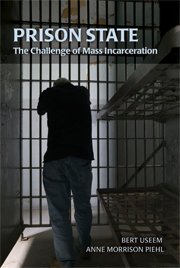Book contents
- Frontmatter
- Contents
- Acknowledgments
- 1 The Buildup to Mass Incarceration
- 2 Causes of the Prison Buildup
- 3 More Prison, Less Crime?
- 4 Prison Buildup and Disorder
- 5 The Buildup and Inmate Release
- 6 Impact of the Buildup on the Labor Market
- 7 Conclusion: Right-Sizing Prison
- Notes
- Index
- CAMBRIDGE STUDIES IN CRIMINOLOGY
4 - Prison Buildup and Disorder
Published online by Cambridge University Press: 31 January 2011
- Frontmatter
- Contents
- Acknowledgments
- 1 The Buildup to Mass Incarceration
- 2 Causes of the Prison Buildup
- 3 More Prison, Less Crime?
- 4 Prison Buildup and Disorder
- 5 The Buildup and Inmate Release
- 6 Impact of the Buildup on the Labor Market
- 7 Conclusion: Right-Sizing Prison
- Notes
- Index
- CAMBRIDGE STUDIES IN CRIMINOLOGY
Summary
Turning and Turning in the widening gyre
The falcon cannot hear the falconer;
Things fall apart; the centre cannot hold;
Mere anarchy is loosed upon the world.
There was in the France of 1789, the Russia of 1917, the Italy of 1922, the Germany of 1932, a vacuum of power which political nature abhors.
During the course of the U.S. prison buildup and even toward its end, many criminologists predicted that the buildup would be extremely difficult if not impossible to implement, and that they expected a crisis of order exemplified by high rates of riots, violence, and escapes. Criminologist John Hagan warned that “increased imprisonment will lead to more disruptions and riots in prisons.” Based on this prediction, as well as a belief that prison does little to reduce crime, Hagan advocated that we should “have as few of these inherently unstable institutions as possible.” Similarly, Thomas Blomberg and Karol Lucken cautioned that we reap what we sow, now and into the future:
It does not appear likely that prisons will fare any better in the future. Rather, and quite the opposite, it appears that prisons will worsen in conditions and inmate consequences…. Prison riots, hostage taking, gang warfare, and inmate to inmate, inmate to staff, and staff to inmate violence are all increasingly routine aspects of everyday operations.
At least during the buildup period, no one could have known what would happen behind bars as the number of prisoners climbed toward, and eventually surpassed, the 1 million mark.
- Type
- Chapter
- Information
- Prison StateThe Challenge of Mass Incarceration, pp. 81 - 115Publisher: Cambridge University PressPrint publication year: 2008

